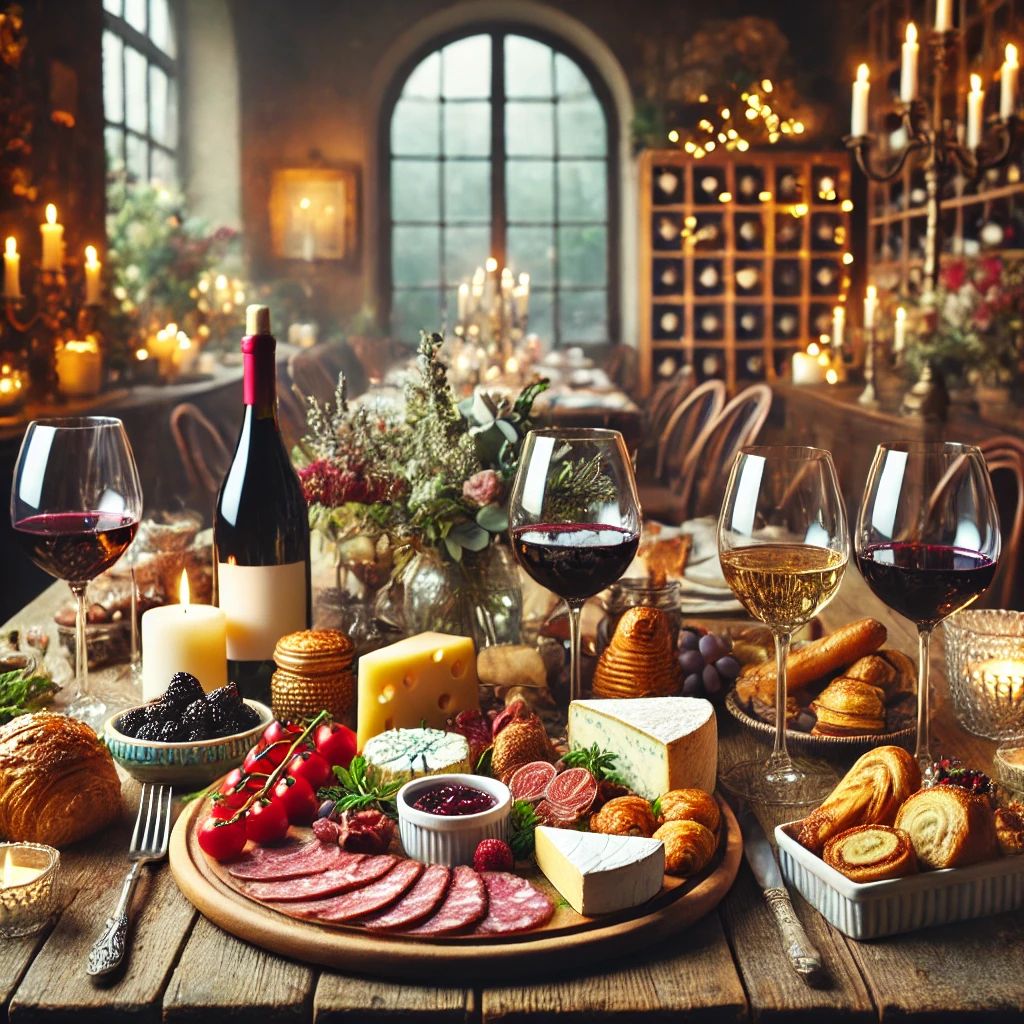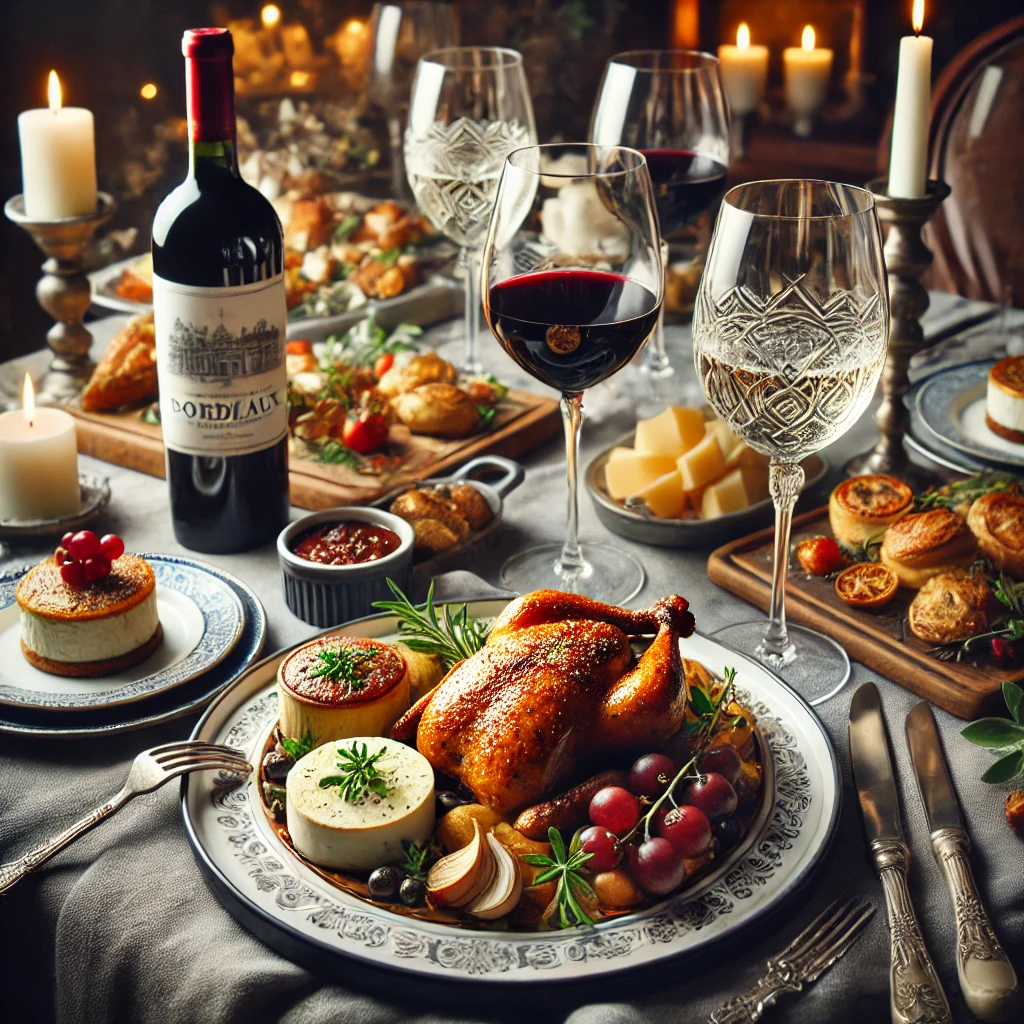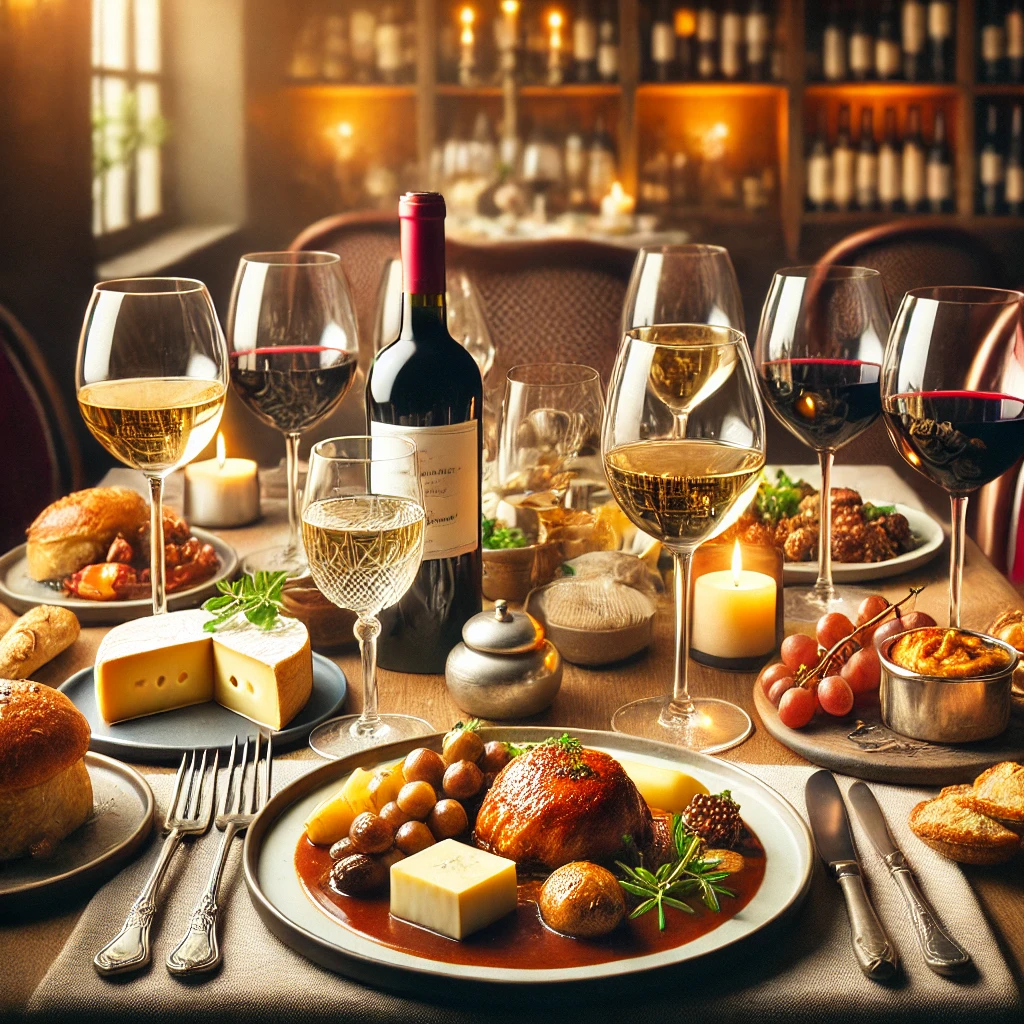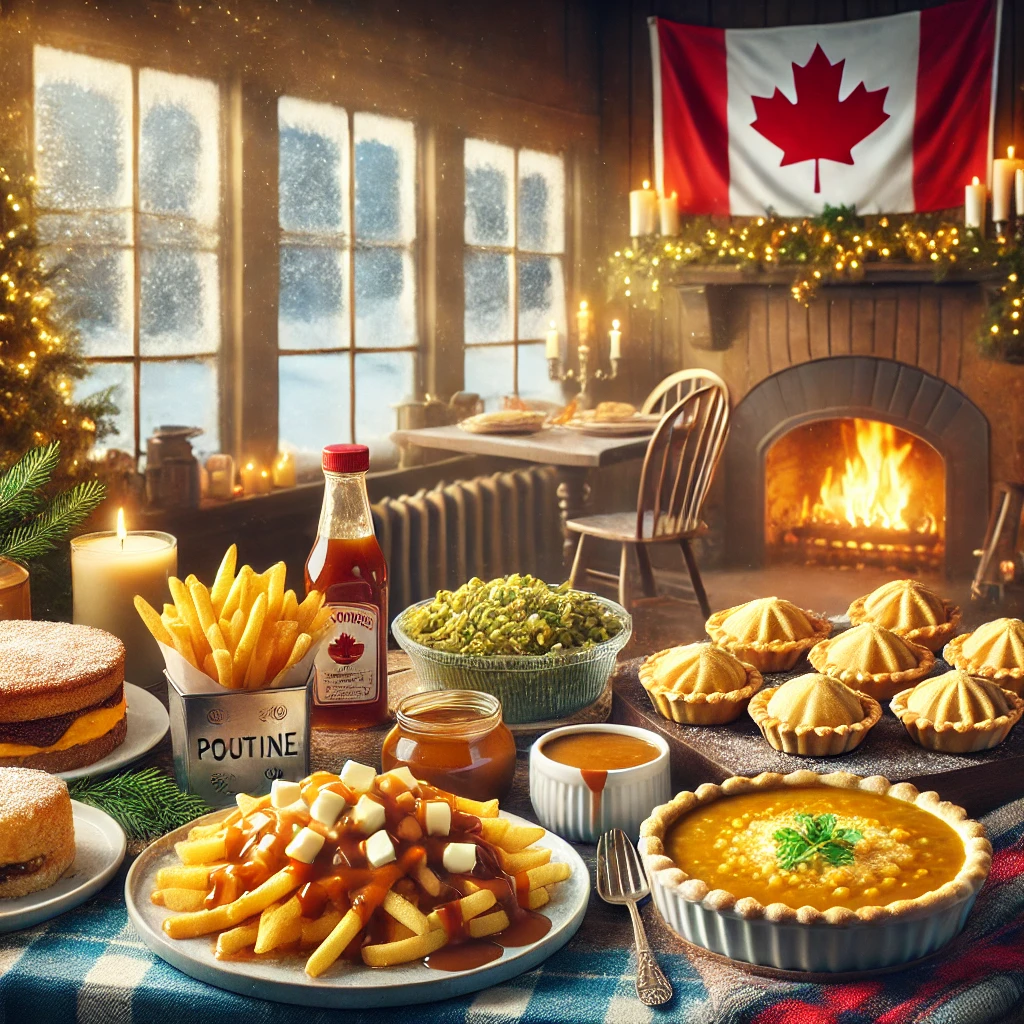Table of Contents

Introduction to French Culinary and Winemaking Artistry
French cuisine and winemaking are globally revered, encapsulating an extraordinary blend of tradition, innovation, and terroir. The rich tapestry of French gastronomy traces its origins to medieval times and has since evolved into a refined art form that emphasizes both intricate cooking techniques and the harmony of flavors. French cuisine’s hallmark lies in its diversity, with each region offering distinct dishes and culinary styles rooted in local ingredients and culture.
Similarly, France’s winemaking heritage is equally illustrious. The French terroir, marked by its varied climates and soils, plays a pivotal role in shaping the distinctive characteristics of its wines. From the delicate, aromatic whites of the Loire Valley to the robust reds of Bordeaux, each wine region reflects the unique nuances of its environment. This symbiotic relationship between geography and viticulture has cemented France’s position as a leader in the global wine industry.
Food and wine pairings hold significant cultural and gastronomic importance in French dining traditions. The French have long believed that the right pairing accentuates the flavors of both the dish and the wine, creating a more profound and pleasurable dining experience. Whether it’s a buttery escargot paired with a crisp Chardonnay or a rich Boeuf Bourguignon complemented by a velvety Pinot Noir, these combinations are meticulously crafted to enhance the overall sensory experience.
In this blog post, we will delve into the intricacies of French food and wine pairings, offering insights into the principles that guide these harmonies. From exploring the foundational elements of French cuisine to mapping out key wine regions and their specialties, readers will gain a comprehensive understanding of how to bring a taste of France to their dining tables. Join us as we embark on this culinary journey, discovering the perfect pairings that epitomize the elegance of French dining.
The Basics: Understanding Wine Pairings with French Cuisine
Pairing wine with French cuisine is both an art and a science rooted in the understanding of different wine characteristics and their complementary nature with the flavors, textures, and ingredients of various dishes. Acidity, sweetness, tannin levels, and body are the primary factors that influence a perfect pairing.
Acidity is one of the most crucial elements in wine pairing. Wines with high acidity, such as Sauvignon Blanc or Chablis, work well with dishes that are rich and creamy. The acidity cuts through the richness, providing a balanced contrast. For example, Chablis pairs wonderfully with buttery escargot or a creamy cheese like Brie.
Sweetness in wine can enhance the flavors of spicy or salty dishes. A classic example is a Sauternes paired with foie gras, where the wine’s sweetness complements the savory, fatty nature of the dish, creating a harmonious blend of flavors.
Tannin levels are another consideration, particularly with red wines. Tannins can provide structure and complexity, and they pair well with fatty or protein-heavy dishes. A robust Bordeaux, with its rich tannins, is an excellent match for grilled meats like a juicy steak or rack of lamb. The tannins bind with the proteins and fat, enhancing the overall dining experience.
The body of the wine, whether light, medium, or full-bodied, should align with the weight of the dish. A delicate dish like sole meunière pairs best with a light-bodied wine like a Pinot Noir. Conversely, a hearty beef bourguignon is enhanced by a full-bodied red such as a Rhône blend.
These principles offer a fundamental framework for pairing wine with French cuisine. By considering acidity, sweetness, tannin levels, and body, one can create pairings that elevate a meal, bringing out the best in both the food and the wine. As you explore these combinations, you’ll uncover the intricate dance that makes French dining truly exceptional.
Elegant Entrées: Pairing Wines with French Starters
French cuisine is renowned for its sophisticated starters, which set the tone for an exquisite dining experience. Among these, escargots, foie gras, and cheese soufflés stand out as quintessential delicacies. To enhance these appetizers, selecting the right wine is paramount. Each dish possesses unique flavor profiles and textures that demand thoughtful wine pairings.
Escargots, typically served with garlic and herb butter, present a rich and earthy taste. A classic pairing for this dish is a crisp white wine, such as Chablis. Chablis, hailing from the Burgundy region, offers a minerality and acidity that beautifully cut through the richness of the butter, enhancing the subtle flavors of the snails. Alternatively, a Sauvignon Blanc from the Loire Valley provides a refreshing citrus and herbaceous note that complements the dish’s herbal ingredients.
Foie gras, a luxurious liver pâté, requires a wine that matches its creamy texture and depth of flavor. Sauternes, a sweet wine from Bordeaux, is traditionally served with foie gras. The wine’s sweetness and balanced acidity elevate the dish’s savory, silky character, creating a harmonious balance. For those preferring a non-sweet option, a late-harvest Riesling can also provide an excellent counterpoint with its fruity and slightly honeyed profile.
Cheese soufflé, light yet flavorful, demands a wine that can complement its delicate nature without overwhelming it. A white Burgundy, known for its elegant and buttery Chardonnay, is an apt choice. The wine’s subtle oak notes and smooth finish meld seamlessly with the soufflé’s airy texture. Another splendid pairing is a Chenin Blanc from the Loire Valley, which offers bright acidity and stone fruit flavors that accentuate the soufflé’s nuanced cheesy essence.
In essence, the key to pairing wine with French starters lies in understanding the balance of flavors and textures. By choosing wines that either complement or contrast the rich and varied profiles of these traditional appetizers, one can elevate the dining experience to new heights.
Main Course Marvels: Wines for Iconic French Dishes
The rich tapestry of French cuisine offers a plethora of iconic main courses, each deserving an equally distinguished wine pairing. The key to achieving perfection lies in balancing the robustness of the dish with the nuances of the wine. Let’s start with Coq au Vin, a classic French dish featuring chicken braised in red wine with mushrooms, onions, and bacon. The ideal pairing for Coq au Vin is a Burgundy Pinot Noir. The wine’s light body, bright acidity, and subtle tannins complement the dish’s earthy and savory flavors, ensuring a harmonious dining experience.
Next, we delve into the depths of Bouillabaisse, a traditional Provençal fish stew brimming with a variety of seafood and aromatic herbs. A white wine from the southern Rhone Valley, such as a Châteauneuf-du-Pape Blanc, makes an excellent partner for Bouillabaisse. This wine’s rich texture and aromatic intensity mirror the complexity of the stew, while its crisp acidity cuts through the richness of the seafood, creating a well-rounded and satisfying pairing.
Lastly, Ratatouille, a vegetable medley of Provence, showcases the simplicity and elegance of French cuisine. When seeking to complement this vibrant and hearty stew, a light and refreshing Rosé from Provence proves to be a stellar option. The wine’s delicate fruit flavors and crisp finish enhance the dish’s bright, garden-fresh ingredients, providing a delicate counterbalance to its rustic charm.
In summary, the interplay between the intensity of flavors in French cuisine and the characteristics of wine is a delicate art. By understanding the principles behind these pairings—such as choosing wines that either mirror or contrast the dish’s dominant flavors—one can elevate the dining experience to new heights. Whether it is the elegance of Coq au Vin with Pinot Noir, the aromatic harmony of Bouillabaisse with Châteauneuf-du-Pape Blanc, or the lively match of Ratatouille with a Provençal Rosé, these pairings exemplify the quintessential marriage of French food and wine.
Elevating the Experience: Wine Pairings for French Sides and Salads
While French cuisine is celebrated for its sophisticated mains, the side dishes and salads play an indispensable role in creating a harmonious dining experience. The interplay of flavors in classic accompaniments like Ratatouille, Niçoise salad, and Gratin Dauphinois can be elevated markedly with well-considered wine pairings.
Ratatouille, a vibrant Provençal vegetable medley of tomatoes, zucchini, eggplant, and peppers, calls for wines that complement its earthy and slightly acidic profile. A red Côtes du Rhône, with its blend of Syrah and Grenache, offers a balanced mix of spiciness and fruitiness that can enhance the ratatouille’s rich flavors. Alternatively, a crisp and mineral-driven Sancerre, made from Sauvignon Blanc, can provide a refreshing contrast to the dish’s roasted vegetables, making each bite and sip a complementary delight.
The Niçoise salad, replete with fresh tuna or anchovies, olives, green beans, and hard-boiled eggs, presents a medley of briny and herbaceous notes. For a seamless pairing, a Rosé from Provence remains an exemplary choice. The fruity and floral overtones of the Rosé synergize beautifully with the salad’s diverse ingredients, bringing harmony to the palate without overwhelming the senses. Those who prefer a white wine might opt for a Chablis, known for its steely acidity and subtle minerality, ideal for the crisp vegetables.
When it comes to Gratin Dauphinois, the creamy, garlicky scalloped potatoes, richer wines are in order. A buttery, oak-aged Chardonnay from Burgundy complements the dish’s decadence with its own velvety texture and complexity. This wine’s luscious notes of vanilla and almond echo the dish’s creaminess, creating a full-bodied pairing. For those inclined towards red wine, a Pinot Noir is an excellent alternative, with its lighter tannins and bright red fruit flavors complementing the gratin without overpowering it.
Selecting the right wines for French sides and salads not only elevates the individual dishes but also weaves a greater sense of cohesion through the entire meal. By thoughtfully aligning wines with these often underappreciated accompaniments, one can fully appreciate the nuanced elegance that defines French dining.“`html
Divine Desserts: Sweet Pairings for French Pâtisserie
When it comes to French cuisine, the art of pairing wines with desserts is just as intricate and enjoyable as any other course. French pâtisserie offers a wide array of delicacies, each with its unique flavors and textures. Understanding how to choose the right wine is crucial to enhancing your dining experience, particularly with classic French desserts like Crème Brûlée, Tarte Tatin, and Macarons.
Crème Brûlée, with its velvety vanilla custard and brittle caramelized sugar top, pairs exquisitely with a Sauternes. This sweet, golden wine from the Bordeaux region complements the creamy texture of the dessert while its honey and apricot notes harmonize with the caramel undertones. Another excellent option is a late-harvest Riesling, which offers a balanced sweetness and acidity, cutting through the richness of the Crème Brûlée without overpowering it.
The Tarte Tatin, an upside-down fruit tart typically made with apples, finds a perfect companion in a glass of demi-sec Champagne. The effervescence of the Champagne contrasts delightfully with the caramelized apples, adding a layer of sophistication to the pairing. For those who prefer a still wine, a slightly chilled Chenin Blanc from the Loire Valley works wonderfully. Its crisp, floral character and mild sweetness accentuate the delicate caramel and fruit flavors in the Tarte Tatin.
Macarons, those delicate and colorful almond meringue cookies, offer a spectrum of flavors from raspberry to chocolate to pistachio. For a versatile wine pairing, consider a Moscato d’Asti. Its light fizziness and delightful sweetness match well with various macaron flavors without overwhelming them. For a more opulent choice, a glass of Crémant—a sparkling wine from regions such as Alsace or Burgundy—provides a refined pairing that enhances the luxurious texture of the macarons.
In French cuisine, the delicate balance of flavors and textures in desserts requires thoughtful wine pairings to truly shine. By understanding the unique characteristics of wines like Sauternes, Champagne, and Chenin Blanc, one can elevate the experience of enjoying classic French pâtisserie to new heights.
Cheese Course: The Perfect Wine Companions for French Cheeses
In French cuisine, the cheese course holds a special significance, often presented either as an appetizer or as a transition between the main course and dessert. Understanding the nuances of pairing wines with French cheeses is essential for achieving a harmonious dining experience. This section will explore ideal wine pairings for some of the most renowned French cheeses, namely Brie, Roquefort, and Camembert, each with its own distinct characteristics that can be accentuated or balanced by various wine choices.
Brie, a soft cheese with a milky and buttery texture, demands a wine that complements its creaminess without overwhelming its delicate flavors. A classic choice is a Chardonnay from Burgundy, known for its balanced acidity and subtle oak notes. The wine’s crispness and medium body can counterbalance the richness of Brie, enhancing its smooth, earthy undertones. Alternatively, Champagne provides an excellent pairing due to its bubbly nature and high acidity, cutting through the cheese’s fat content and refreshing the palate.
Roquefort, a blue cheese revered for its bold and tangy profile, requires a wine that can stand up to its strong character. The sweet and luscious qualities of Sauternes, a dessert wine from the Bordeaux region, make it an exceptional companion. The wine’s honeyed notes and vibrant acidity create a delightful contrast with Roquefort’s salty pungency, producing a balanced and complex taste experience. For those preferring a red wine, a robust and fruity Port also pairs well, offering a different yet equally complementary flavor dynamic.
Camembert, sharing some similarities with Brie but hosting a more pronounced aroma and a slightly firmer texture, pairs beautifully with a red Bordeaux. The wine’s tannic structure and dark fruit flavors can enhance the cheese’s earthiness, providing a robust accompaniment. Another excellent choice is a crisp and mineral-rich Sauvignon Blanc from the Loire Valley, which can highlight Camembert’s creamy consistency while adding a refreshing contrast.
Pairing the right wine with French cheeses is a delightful endeavor that exemplifies the sophistication of French cuisine. By considering the individual characteristics of cheeses like Brie, Roquefort, and Camembert, and selecting wines that either balance or amplify their flavors, one can create a truly memorable gastronomic experience.
Conclusion: Crafting Memorable French Wine and Food Experiences
Creating the perfect French wine and food pairing is an art that blends tradition, balance, and personal preference. As you embark on this culinary journey, remember that harmony between the flavors in your French cuisine and the characteristics of your chosen wine is paramount. To achieve this balance, consider the weight, texture, and intensity of both your dish and your wine. For instance, a rich, creamy dish like Coq au Vin pairs exquisitely with an earthy Burgundy, while a lighter option like a crisp Sauvignon Blanc complements the nuanced flavors of a delicate seafood platter.
Exploration and experimentation are key. Don’t be afraid to step outside conventional pairings and discover what pleases your palate. Trying different wine varieties with classic French dishes can lead to unexpected yet delightful combinations that may become your personal favorites. For those new to French cuisine and wine pairings, starting with regional specialties is a great way to ground your experiences. As you grow more confident, gradually expand to less traditional pairings.
For those seeking to deepen their knowledge, numerous resources are available. Books such as “The Wine Bible” by Karen MacNeil and “French Wine For Dummies” offer comprehensive insights into wine selection and pairing. Online platforms like Coursera and MasterClass feature courses from experts who can guide you through the intricacies of French wine and gastronomic traditions. Additionally, websites and blogs dedicated to French cuisine and wine continue to be valuable resources for tips, recommendations, and emerging trends.
Ultimately, the ultimate goal is to craft memorable dining experiences that reflect your unique tastes and preferences. As you continue to explore the delightful world of French food and wine, always keep balance, experimentation, and continuous learning at the forefront of your culinary adventures.






